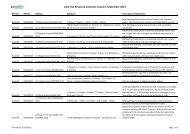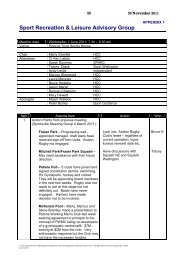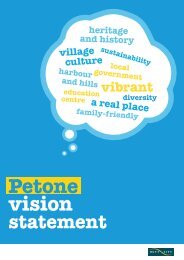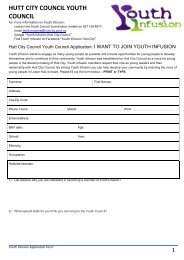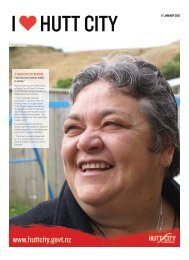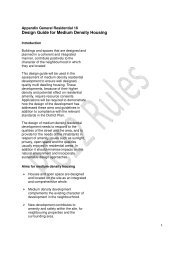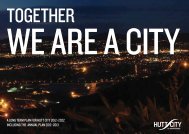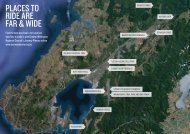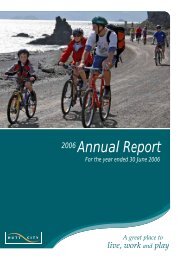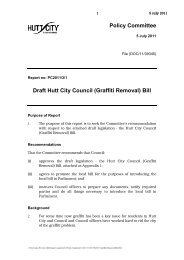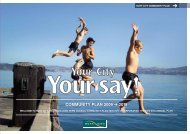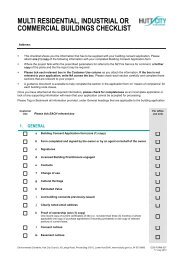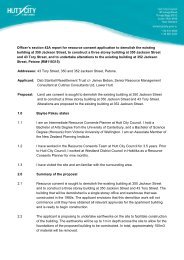Little blue penguin reserve management plan.pdf - Hutt City Council
Little blue penguin reserve management plan.pdf - Hutt City Council
Little blue penguin reserve management plan.pdf - Hutt City Council
You also want an ePaper? Increase the reach of your titles
YUMPU automatically turns print PDFs into web optimized ePapers that Google loves.
There are a number of ‘Multi’ <strong>reserve</strong>s included within the series of Reserve ManagementPlans. Multi <strong>reserve</strong>s are those <strong>reserve</strong>s that contain differing characteristics and<strong>management</strong> within the one land parcel. This in turn means that more than oneManagement Plan applies to that area. The following <strong>reserve</strong>s are considered to be ‘Multi’.Avalon ParkBryan Heath ParkDelaney ParkDowse Drive ReserveFrank Cameron ParkHikoikoi Reserve / McEwan and Lions Park<strong>Hutt</strong> Rec / Huia PoolHW Shortt ParkLeonard Wood ParkMemorial Park/Garden of RemembranceNaenae ParkNgaturi ParkNorth ParkRichard Prouse ParkTaita CemeteryTe Whiti ParkWilliam Jones ParkWilliam Jones Swimming PoolWilliams ParkWingate ParkWise Park/Hugh Sinclair ParkThe overall design and structure of the Management Plans are generic in nature allowing theapplication of general policy while providing flexibility in the application of specifics to<strong>reserve</strong>s with unique characteristics. The Management Plans are not exhausted with thespecific detail of development proposed for every <strong>reserve</strong> in the <strong>City</strong>, but rather use policiesto guide any future development and operations in a consistent manner.The Reserve Management Plans are to be used alongside the <strong>Hutt</strong> <strong>City</strong> <strong>Council</strong> ReservesDraft Strategic Directions and the <strong>City</strong> of Lower <strong>Hutt</strong> Proposed District Plan 1995 inachieving any outcomes.On Tuesday 27 May 2003 the <strong>Hutt</strong> <strong>City</strong> <strong>Council</strong> confirmed the completion of thereview of the Sportsground Reserves Management Plan under the Reserves Act1977. The 2003 Reviewed Plan is now adopted as <strong>Council</strong> policy and is operationalunder the Reserves Act 1977.ii
TABLE OF CONTENTS1. Introduction 11.1 Management Plan Review Process 11.2 Purpose of a Reserves Management Plan 11.3 Identification of Sportsground Reserves 11.4 Sportsgrounds covered by this Management Plan ........................................................................1.6.............................................................................................................................. Legislation1.6 Consultation...................................................................................................................................1.7 Management and Monitoring .........................................................................................................2. The <strong>City</strong> of Lower <strong>Hutt</strong> Proposed District Plan 1995 33. The <strong>Hutt</strong> <strong>City</strong> <strong>Council</strong> Bylaw 1997 34. Aims 35. Sportsground Description 36. Issues, Objectives and Policies 76.1 Statutory and Legal Requirements 76.2 Iwi Mana Whenua 76.3 Consultation 86.4 Effects on Adjacent or Neighbouring Properties............................................................................6.5 Access 96.6 Car Parking 106.7 Refuse Disposal.............................................................................................................................6.8 Restricted Activities 116.9 Leases and Licences 126.10 Fees and Ground Charges 136.11 Sale of Liquor 146.12 Natural Features and Open Space 146.13 Maintenance of Sportsgrounds......................................................................................................6.14 Use of Hazardous Chemicals 166.15 Signs 176.16 Rights of Way and other Easements 186.17 Ground Allocation and Use of Sportsgrounds 196.18 Passive and Informal Recreation 206.19 Multiple Use of Sports Facilities 206.20 Maintenance of Sports Facilities 216.21 Major Events 216.22 Organised Social Games 226.23 Artificial Surfaces 226.24 Sportsground Closures 236.25 Retail and Commercial Recreation Activities 236.26 Limiting Development on Sportsgrounds 246.27 Design, Frequency and Location of Buildings and Structures 246.28 Floodlighting 256.29 Development in the River Corridor 26iii
AppendicesAppendix 1 – Legal Listings of Sportsground ReservesAppendix 2 – Aerial Photographs of Sportsground ReservesAppendix 3 - <strong>Hutt</strong> <strong>City</strong> <strong>Council</strong> Bylaw - Part 12 - Parks and ReservesAppendix 4 - <strong>Hutt</strong> <strong>City</strong> <strong>Council</strong> Bylaw - Part 4 - Dog Control- Schedule 1 – Prohibited Places- Schedule 2 – Dog Exercise Areasiv
1. INTRODUCTION1.1 Management Plan Review ProcessThis document is a review of the Reserve Management Plan for Sportsgrounds, firstpublished in January 1998. The review of <strong>management</strong> <strong>plan</strong>s is a requirement under section41(4) of the Reserves Act 1977. “The administering body of any <strong>reserve</strong> shall keep its<strong>management</strong> <strong>plan</strong> under continuous review, so that, subject to subsection (3) of this section,the <strong>plan</strong> is adapted to changing circumstances or in accordance with increased knowledge”.Under the Reserves Act Guide 1999 “Generally, <strong>plan</strong>s should be reviewed at a minimum of10 year intervals and need not involve a complete rewriting”. The <strong>Hutt</strong> <strong>City</strong> <strong>Council</strong>employs a best practice approach with a document review process to be completed on a fiveyear turn around period. This ensures that any <strong>management</strong> or operational changes areaccurately reflected and addressed within the <strong>management</strong> <strong>plan</strong>.The review of the Sportground Reserve Management Plan is a process that largely capturesnew or reclassified sportsground <strong>reserve</strong>s. Periodical review of the <strong>plan</strong> also ensures that thestyle and format is consistent with the current series of <strong>management</strong> <strong>plan</strong>s, ensuring ease ofuse and coherency.1.2 Purpose of a Reserve Management PlanThe purpose of the Sportsgrounds Reserve Management Plan (hereafter referred to as the“Management Plan”) is to provide a policy framework for the use, enjoyment, maintenance,protection, and appropriate development of Sportsground Reserves throughout the <strong>City</strong> ofLower <strong>Hutt</strong>. This will ensure consistency in terms of the <strong>management</strong> of current <strong>reserve</strong>sand the establishment of future <strong>reserve</strong>s. This Management Plan shall supersede any pastReserve Management Plan that applied to any of the Sportsground Reserves identified inthis document. This Management Plan applies to all <strong>Council</strong> Sportsground Reserves listedin Appendix 1 regardless of classification under the Reserves Act 1977 and has beenprepared in accordance with the procedures outlined in section 41 of that Act.1.3 Identification of Sportsground ReservesSites identified to be included in the Management Plan are those where any part ofrecreational grounds associated with sports and associated facilities primarily provide forformally organised sporting activities. Sportsground Reserves generally have similarcharacteristics and purposes, and therefore a single generic <strong>plan</strong> has been prepared to coversuch <strong>reserve</strong>s. This is to ensure that all Sportsground Reserves are used and developed in amanner consistent with their purpose.Sportsground Reserves are either properties managed by <strong>Council</strong> and held in fee simpleownership for <strong>reserve</strong> purposes, or <strong>reserve</strong>s that are classified as such under the ReservesAct 1977. All Sportsground Reserves listed in this Management Plan will be managed anddeveloped in accordance with the Reserves Act 1977, as it is desirable to achieve the same<strong>management</strong> and development objectives for all <strong>reserve</strong>s of a similar nature. Including areasheld in fee simple ownership by the <strong>Council</strong>, does not however, give them any status as<strong>reserve</strong>s under the Reserves Act 1977. Any additional <strong>reserve</strong>s identified in the future,which are developed for Sportsground purposes, will be added to this Management Planand will be publicly notified in accordance with the provisions of the Reserves Act 1977.<strong>Little</strong> Blue Penguin Reserve Management Plan – Reviewed May 2003i
1.4 Sportsgrounds Covered by this Management PlanThe following sportsgrounds are covered either in part or in full by this <strong>management</strong> <strong>plan</strong>:Arakura ParkBell ParkBryan Heath ParkFraser Park<strong>Hutt</strong> Recreation GroundKaraka ParkMary Crowther ParkMemorial ParkNgaturi ParkPetone Recreation GroundRiverside OvalTrafalgar ParkWilliams ParkYork ParkAva ParkBishop ParkDelaney ParkFrederick Wise ParkH W Shortt Recreation GroundLeonard Wood ParkMcEwan ParkNaenae ParkNorth ParkRichard Prouse ParkSladden ParkTe Whiti ParkWilliam Jones ParkWingate ParkNot all the parks and recreation grounds listed above are included in their entirety in this <strong>management</strong><strong>plan</strong>. In many cases, the actual sportsground and associated facilities (such as clubrooms, grandstandsand floodlights) only make up a part of a park or recreation ground. The approach taken in this<strong>management</strong> <strong>plan</strong> has been to allocate the remainder of the park or recreation ground to a <strong>management</strong><strong>plan</strong> that is appropriate for the use of the area. For example, on <strong>Hutt</strong> Recreation Ground the Huia Poolcomplex is included in the Facility Reserve Management Plan, while at Williams Park the open spaceand bush areas are addressed respectively in the Amenity Horticulture and Bush Reserve ManagementPlans. The actual extent of area included in the sportsground <strong>reserve</strong> <strong>management</strong> <strong>plan</strong> is depicted onthe aerial photographs included in Appendix 2. The provisions of this <strong>management</strong> <strong>plan</strong> relate only tothe area inside the defined boundaries.Any sportsground and associated facilities developed in the future which primarily provides fororganised active recreation, will be added to this <strong>management</strong> <strong>plan</strong>. Such an addition will be publiclynotified in accordance with the provisions of the Reserves Act 1977.1.6 LegislationThe Reserves Act 1977 guides the preparation and implementation of <strong>reserve</strong> <strong>management</strong><strong>plan</strong>s. Other legislation that is of relevance in the preparation of this document includes theResource Management Act 1991, Building Act 1991, Sale of Liquor Act 1989, and the Healthand Safety in Employment Act 1992.1.6 ConsultationPublic notification of this Draft is provided for under sections 41 and 119 of the Reserves Act1977, and notice was given in the <strong>Hutt</strong> News, as well as a mail out to likely interest groupsand lessees. Publicity material was also prepared and distributed for display at all <strong>Council</strong>Libraries.<strong>Little</strong> Blue Penguin Reserve Management Plan – Reviewed May 2003ii
1.7 Management and MonitoringThis Management Plan will be fully reviewed at five yearly intervals. In addition, acontinuous process of monitoring the Management Plan will be carried out, with <strong>Council</strong>making alterations and additions as changing circumstances or increased knowledge mayrequire. Any proposed changes will be publicly notified in accordance with the provisionsof the Reserves Act 1977.2. THE CITY OF LOWER HUTT PROPOSED DISTRICT PLAN 1995The <strong>City</strong> of Lower <strong>Hutt</strong> Proposed District Plan 1995 places <strong>reserve</strong>s within one of the fourrecreation activity areas. Issues, objectives, policies and rules have been developed for eachof these activity areas. These provide an overall <strong>management</strong> framework for the type ofactivities and structures that can be located on <strong>reserve</strong>s. The majority of SportsgroundReserves are provided for as General Recreation Activity Areas under The <strong>City</strong> of Lower<strong>Hutt</strong> Proposed District Plan 1995. The Resource Management Act 1991 and the Reserves Act1977 become interrelated in the <strong>management</strong> of <strong>reserve</strong>s through the approach taken in theProposed District Plan 1995.3. THE HUTT CITY COUNCIL BYLAW 1997The <strong>Hutt</strong> <strong>City</strong> <strong>Council</strong> Bylaw 1997 (relevant parts included in appendices) outlinesconditions for the operation of parks and <strong>reserve</strong>s. This includes requirements for the hoursof operation, closing of <strong>reserve</strong>s, imposing of conditions, offences and any other prohibitedactivities. The provisions for public places and dog control are also of relevance to thisManagement Plan. This Bylaw should be read alongside the provisions of this SportsgroundReserves Management Plan.4. AIMSThe aims of this <strong>management</strong> <strong>plan</strong> are to:• provide the general public with opportunities to undertake active organised recreation primarily,and to a lesser extent the opportunity to undertake passive recreation activities;• provide a policy framework with which to manage potential conflict on sportsgrounds;• ensure a consistent approach is undertaken with regard to the <strong>management</strong> and development ofsportsgrounds and associated facilities on sportsgrounds; and• ensure that all activities on sportsgrounds are undertaken in accordance with the Reserves Act.5. SPORTSGROUND DESCRIPTIONThis section provides a brief description of the location, use and facilities present on each ofthe sportsgrounds included in this <strong>management</strong> <strong>plan</strong>. Legal information relating to thesesportsgrounds is found in Appendix 1. Aerial photographs which depict the sportsgroundboundary and legal descriptions are found in Appendix 2.While there are a number of playgrounds located on sportsgrounds, the <strong>management</strong> anddevelopment of these facilities will be addressed in the Management Plan forNeighbourhood Reserves.<strong>Little</strong> Blue Penguin Reserve Management Plan – Reviewed May 2003iii
Arakura Park - is located in Wainuiomata, with access off Upper Fitzherbert, Wellington andMatthews Roads. Soccer is played on the park. The park has clubrooms, floodlights and aplayground.Ava Park - runs along the western side of the <strong>Hutt</strong> River, with access off Wakefield andMontague Streets. The park is primarily used for passive recreation activities, includingrunning, cycling and dog walking, although it can be used as an overflow for junior sportsshould demand necessitate it. The land is owned by the Wellington Regional <strong>Council</strong> but<strong>Hutt</strong> <strong>City</strong> <strong>Council</strong> is responsible for the <strong>management</strong> of the park.Bell Park - is located in Gracefield with access off Bell Road, Riverside Drive and DouglasStreet. It is primarily used for soccer and has spectator seating, storage facilities andclubrooms.Bishop Park - lies between Marine Parade, Eastbourne and the foreshore at Rona Bay. Thepark is screened from the sea by a narrow dune area which extends south to the swimmingpool. Bishop Park doubles as a sportsground and picnic/community area. There is a juniorand senior size soccer field, and junior cricket is played here. There are clubrooms at thesouthern end of the park.Bryan Heath Park - fronts on to Fitzherbert Road, Wainuiomata. There are clubrooms andassociated car parking on the park, and soccer and cricket are played here.Delaney Park - is located in George Street, Stokes Valley, with pedestrian access off StokesValley Road. Cricket, touch rugby, rugby and soccer are played on the park. The rugby clubhave their own clubrooms and gymnasium at the northern end of the park, while the cricketand soccer clubs share clubrooms at the southern end.Fraser Park - is the largest sportsground in <strong>Hutt</strong> <strong>City</strong>, and is located between Avalon andTaita. Access to the Park is available off Harcourt Werry Drive, Percy Cameron Street andTaita Drive. A number of sports are played here including, hockey, rugby, rugby league,soccer, touch rugby, cricket and softball. There are a number of facilities on the park,including an artificial hockey surface, clubrooms, changing rooms, gymnasium, floodlightsand a grandstand and associated enclosure. The enclosure area at the park is a chargeground. The stop bank runs through the middle of the park, and thus much of the park is inthe river corridor. The area on the river side of the stop bank is commonly known as theFraser Park extension, and is owned by the Wellington Regional <strong>Council</strong>. This Park isadministered by the <strong>Hutt</strong> <strong>City</strong> <strong>Council</strong>.Frederick Wise Park - is a large sportsground in Wainuiomata. Located off Fitzherbert Roadand Parkway, the park is home to touch rugby, softball, rugby league and sometimes juniorrugby. Facilities include a clubrooms, tiered seating, lime softball diamond, and part of thepark can be used as a charge ground.The <strong>Hutt</strong> Recreation Ground - is located in Central <strong>Hutt</strong>, with access to the ground offWoburn and Bellevue Roads and Myrtle Street. The ground is used for touch rugby, cricket,athletics, rugby and occasionally rugby league. There are clubrooms, a gymnasium,floodlights and a grandstand on site, and it can be used as a charge ground. The <strong>Hutt</strong>Districts Cricket Club’s facilities include accommodation for an on-site custodian. Theground is sometimes used for major sporting or recreation events.<strong>Little</strong> Blue Penguin Reserve Management Plan – Reviewed May 2003iv
Oak trees <strong>plan</strong>ted in 1937 run along the Woburn Road boundary of the ground, and also linethe driveway from Woburn Road to the entrance to the grandstand. Attached to the trees arecommemorative plaques honouring past Lower <strong>Hutt</strong> mayors. The Huia Pool complex is alsopart of the ground, but will is covered under the Facility Reserves Management Plan.H W Shortt Recreation Ground - previously known as the Eastbourne Recreation Reserve,has access off Tuatoru and Oroua Streets. The ground provides for active recreation in anarea that is relatively short of flat land. There are a number of pohutukawa trees on site.Cricket and rugby are played at the ground, and there are clubrooms and a sports andcommunity centre on site.Karaka Park - is located off Karaka Street, Wainuiomata. Junior rugby is played at the park,and there is a playground on site.Leonard Wood Park - is located in Wainuiomata, with access from Willow Grove and WoodStreet. Soccer is sometimes played on the park, and there are floodlights.Mary Crowther Park - is located in Wainuiomata with the main access coming off WiseStreet. Rugby and cricket are played on the park, and there is a synthetic cricket pitch,changing rooms and floodlights.McEwan Park - is located on the Hikoikoi Reserve along the Petone Foreshore. Touch rugbyand rugby league are played at the park. This <strong>management</strong> <strong>plan</strong> only includes thesportsgrounds and clubrooms at McEwan Park. Other facilities at the Hikoikoi Reserve willbe addressed in the Es<strong>plan</strong>ade and Foreshore Reserve Management Plan. The WellingtonTenths Trust has an interest in the park by way of a Treaty claim.Memorial Park - is located at the end of Bracken Street, Petone, adjacent to Petone College(formerly <strong>Hutt</strong> Valley Memorial). Soccer is played on the park, and there are floodlights,clubrooms, a small grandstand, gymnasium and custodians house. The land is owned by theWellington Regional <strong>Council</strong> and administered by the <strong>Hutt</strong> <strong>City</strong> <strong>Council</strong>.Naenae Park - is located in Naenae, with access off Gibson Crescent, Seddon Street,Waddington Drive and Naenae Road. Rugby league, soccer, touch rugby, cricket, athleticsand softball are played on the park. There is a synthetic cricket pitch, clubrooms, changingrooms, a gymnasium, tiered seating and training lights on site. Very little off-street carparking is available at the park. The kindergarten and playground do not form part of this<strong>management</strong> <strong>plan</strong>.Ngaturi Park - is located in Wainuiomata, with access off Coast Road, Parenga Street andNgaturi Grove. The park is used for rugby and soccer. There is a playground on the park.North Park - is located in Petone, with access from Roxburgh, South, Udy and BouverieStreets. The park is used for rugby, touch rugby and softball, and there are rugby clubroomson site.The Petone Recreation Ground - is the largest sportsground in Petone. The ground hasentrances on Udy, Buick and Britannia Streets and Kensington Avenue. Rugby, touch rugbyand cricket are played at the ground. There is a grandstand, three clubrooms and the groundcan be utilised as a charge ground. There is a playground at the park.<strong>Little</strong> Blue Penguin Reserve Management Plan – Reviewed May 2003v
Richard Prouse Park - is located off Hine Road, Wainuiomata, and has the WainuiomataRiver meandering through it. Athletics, cricket and soccer are played on the park. There areclubrooms and floodlights.Riverside Oval - is located on the eastern bank of the <strong>Hutt</strong> River, with access off HarcourtWerry Drive. Australian rules and Gaelic football are played at the oval. The oval is on theriver side of the stopbank. The land is owned by the Wellington Regional <strong>Council</strong>, butadministered by the <strong>Hutt</strong> <strong>City</strong> <strong>Council</strong>.Sladden Park - is located at the end of Bracken Street, Petone, behind Petone College(formerly <strong>Hutt</strong> Valley Memorial) and Memorial Park. The park is on the western bank of the<strong>Hutt</strong> River, on the river side of the stopbanks. There are toilets on site, and cricket, rugbyand soccer are played here. The land is owned by the Wellington Regional <strong>Council</strong> andadministered by the <strong>Hutt</strong> <strong>City</strong> <strong>Council</strong>.Te Whiti Park - is located at the eastern end of Whites Line East, Waiwhetu. Touch rugby,cricket, soccer, hockey and rugby league are played on the park. There is a synthetic cricketpitch, a gym, and a number of clubrooms on the park, including the Te Aroha SportsAssociation which is part of the Waiwhetu Marae. The Crown and Maori are in negotiationwith respect to Te Whiti Park.Trafalgar Park - is located in Waiwhetu, with access to the park off Trafalgar and BrookStreets. Soccer and cricket are played at the park, and there are clubrooms and changingfacilities located at the northeastern end.William Jones Park - is located on Moohan Street, Wainuiomata. Touch rugby and rugby areplayed on the fields, and there are clubrooms and squash courts. There is a swimming poolon the park, but this is addressed under the Facility Reserves Management Plan.Williams Park - is located on Eastern Bays Marine Drive, Days Bay. It is primarily a passiverecreational park, however the soccer ground and hard court tennis courts will be covered bythis <strong>management</strong> <strong>plan</strong>. The remainder of the park will be addressed in the AmenityHorticulture and Bush Reserves Management Plan.Wingate Park - is located on the Eastern Hills, with access off Page Grove, Wingate. Thepark is the old Wingate tip site, and it is proposed that the area will be developed assportsfields. The site was previously known as the Duke of Edinburgh Park; however, it wasresolved by <strong>Council</strong> in September 1981 that the name of the park be changed to Wingate.York Park - is located in Moera with access off Randwick Road, and York and ElizabethStreets. Soccer is played on the park, and there is a scout hall. An easement for power cablesand a gas main run across the <strong>reserve</strong>.<strong>Little</strong> Blue Penguin Reserve Management Plan – Reviewed May 2003vi
6. ISSUES, OBJECTIVES AND POLICIESIt is fundamental to the <strong>management</strong> and development of sportsgrounds that issues,objectives and policies are clearly defined so that decisions on any activity proposed orcarried out on these sportsgrounds are made in accordance with those provisions.6.1 Statutory and Legal RequirementsIssueThere are a number of statutory and legal requirements that activities on sportsgrounds mustsatisfy.ObjectiveTo ensure that all statutory and legal requirements pertaining to the <strong>management</strong> and use ofsportsgrounds are met.PoliciesThat all activities on sportsgrounds comply with the Building Act 1991, ResourceManagement Act 1991 and any relevant requirements of any Regional Plan or the <strong>City</strong> ofLower <strong>Hutt</strong> Proposed District Plan 1995.(ii)(iii)(iv)(v)(vi)(vii)That sportsgrounds be managed in accordance with their classification under theReserves Act 1977.That sportsgrounds which are held as <strong>Council</strong> freehold be controlled and managed asa <strong>reserve</strong> for the purposes specified in section 17 of the Reserves Act 1977.That sportsgrounds which are incorrectly classified under the Reserves Act 1977 interms of their use, be reclassified appropriately.That all activities on sportsgrounds be controlled and directed in accordance with the<strong>Hutt</strong> <strong>City</strong> <strong>Council</strong> Bylaw 1997 and any other relevant <strong>Council</strong> policy documents.That <strong>Council</strong> employees or any agent undertaking contract work for <strong>Council</strong> shall actin accordance with the requirements of the Health and Safety in Employment Act1992, and <strong>Hutt</strong> <strong>City</strong> <strong>Council</strong>’s Health and Safety Policies.That while <strong>Council</strong> shall take all reasonable care in administering sportsgrounds,users shall use the sportsground entirely at their own risk in every respect. The<strong>Council</strong> shall have no liability for any loss or damage suffered by them.6.2 Iwi Mana WhenuaIssue<strong>Council</strong> has a responsibility to work in partnership with Te Atiawa the Iwi Mana Whenua.<strong>Little</strong> Blue Penguin Reserve Management Plan – Reviewed May 2003vii
ObjectiveTo ensure proposed development and activities on Sportsground <strong>reserve</strong>s are considered inaccordance with the principles of the Treaty of Waitangi.Policies(i)(ii)That Te Atiawa be consulted where a significant development or activity is proposedon a Sportsground Reserve.That <strong>Council</strong> takes account of concerns or issues raised by Te Atiawa or Taura Hereduring the consultation process.6.3 ConsultationIssueA large scale development on a sportsground may have significant adverse effects onsportsground users and adjoining property owners. It is appropriate for these groups to beconsulted so that particular issues of concern can be identified, and more acceptablesolutions may be agreed upon.ObjectiveTo ensure that consultation is carried out with affected parties (this may include neighboursand user groups) where large scale development projects are proposed.Policies(i)(ii)(iii)That the consultation requirements of the Resource Management Act 1991 besatisfied.That consultation be undertaken with affected parties where a large scaledevelopment project is proposed on a sportsground. The design, appearance andlocation of the proposal shall be determined in consultation with affected parties.That the needs and concerns of people who use sportsgrounds for passive recreationactivities be taken into account.6.4 Effects on Adjacent or Neighbouring PropertiesIssueActivities occurring on sportsgrounds may adversely affect the amenity values of adjacent orneighbouring areas. It is important that these adverse effects are adequately mitigated.Where <strong>Council</strong> is responsible for activities such as the location of playing fields, it shall takeaccount of the potential effects on the adjacent or neighbouring properties in order to ensurethe effects are minimised. Where a particular sports or recreation group is causing theadverse effect, that group will be responsible for mitigating the adverse effects.<strong>Little</strong> Blue Penguin Reserve Management Plan – Reviewed May 2003viii
ObjectiveTo ensure the adverse effects of activities on sportsgrounds are adequately mitigated so thatthe amenity values of adjacent or neighbouring properties are not compromised.Policies(i)(ii)(iii)That activities on sportsgrounds must comply with the relevant provisions of the <strong>City</strong>of Lower <strong>Hutt</strong> Proposed District Plan 1995.That the nature and proximity of neighbouring or adjacent properties be consideredwhen the location of playing fields and facilities on sportsgrounds are determined. Toachieve this it may be necessary to consider the location of playing fields, inparticular the goal areas, where spectators may stand, clubrooms and changingrooms, and car park areas.That where sporting, recreation or associated activities are causing a nuisance toadjoining residential properties, the Asset Manager may recommend thatconsultation be undertaken between the sportsground user and the affected propertyowners. This consultation should be directed towards resolving the issues withmitigation measures, which will primarily be the responsibility of the club, sportingor recreation group causing the adverse effects. <strong>Council</strong> is not responsible for anydamage caused by a club, sporting or recreation group.6.5 AccessIssueAllowing unrestricted access onto all sportsgrounds may adversely affect the properfunctioning and amenity values of a sportsground. It is appropriate that <strong>Council</strong> is able torestrict or limit access to sportsgrounds at certain times or in certain circumstances to ensurethe proper functioning and amenity values are not compromised.ObjectiveTo recognise that access to sportsgrounds may from time to time need to be restricted orlimited in some way to ensure the proper functioning and amenity values of sportsgroundsare maintained.Policies(i)(ii)That <strong>Council</strong> may restrict access to sportsgrounds or defined areas of sportsgroundsin certain circumstances (such as for maintenance, construction or other work) or forcertain time periods in accordance with the Reserves Act 1977, and the <strong>Hutt</strong> <strong>City</strong><strong>Council</strong> Bylaw 1997, Part 12 - Parks and Reserves.That some sportsgrounds or defined areas within sportsgrounds will be permanentlyrestricted to the general public to ensure the sporting facility is not damaged orvandalised.<strong>Little</strong> Blue Penguin Reserve Management Plan – Reviewed May 2003ix
(iii)That except for <strong>Council</strong> employees, agents appointed by <strong>Council</strong>, and emergencyservices, vehicular access onto sportsgrounds shall be prohibited unless authorisedby the Asset Manager.6.6 Car ParkingIssueA number of sportsgrounds around the <strong>City</strong> do not have sufficient car parking spaces.Inadequate car parking provision on sportsgrounds leads to poor parking behaviour andcongestion in the neighbouring areas. Proposals for car parking on sportsgrounds will beconsidered where it does not significantly undermine the proper functioning and amenityvalues of a sportsground.ObjectiveTo undertake car park development on sportsgrounds where there is an established need,and where this does not significantly undermine the proper functioning and amenity valuesof sportsgrounds.Policies(i)(ii)(iii)(iv)(v)(vi)That any car park development shall comply with the provisions of the <strong>City</strong> of Lower<strong>Hutt</strong> Proposed District Plan 1995.That car parks may be provided on sportsgrounds where the loss of total usablesportsfield is avoided and the loss of amenity area is minimal.That proposals for car park development be considered on a case by case basis, takingaccount of available funding, the demand for parking on the sportsground, and theeffect of a lack of parking on the surrounding areas.That consideration is made on how to maximise the use of existing car parking areas,while maintaining appropriate landscape <strong>plan</strong>ting.That the installation of security lighting or timer controlled lighting by clubs, sportingor recreation groups in car park and associated areas shall be encouraged, providedany adverse lightspill effects are managed or mitigated.That car parking spaces for people with disabilities be provided as and whenrequired, in accordance with Disabled Persons Community Welfare Act.6.7 Refuse DisposalIssueThe dumping of refuse on sportsgrounds or inappropriate use of existing refuse disposalfacilities, can significantly detract from the amenity values and proper functioning ofsportsgrounds. It is essential that sportsground users are encouraged to use disposalfacilities, but are strongly discouraged from disposing inappropriate refuse.<strong>Little</strong> Blue Penguin Reserve Management Plan – Reviewed May 2003x
ObjectiveTo ensure the proper functioning and amenity values of sportsgrounds are not compromisedby inappropriate refuse being dumped on sportsgrounds, or refuse being dumped in anylocation other than in a facility provided for that purpose.Policies(i)(ii)(iii)(iv)That where appropriate, <strong>Council</strong> shall provide and regularly empty, refuse disposalfacilities at sportsgrounds.That the disposal and collection of refuse on sportsgrounds shall comply with therelevant <strong>Hutt</strong> <strong>City</strong> <strong>Council</strong> Bylaw 1997, in particular Part 12 - Parks and Reserves,and Part 14 - Refuse Collection and Disposal.That no person shall deposit any domestic refuse, trade refuse, dead animals, gardenrefuse, rubble or debris on any part of any sportsground. Legal action will be taken ifpersons are caught committing this offence.That where a special event or tournament (ie. not the weekly club fixtures) is to occuron a sportsground, the user group will be responsible for the collection and disposalof refuse where the quantity of refuse exceeds, or the type of refuse is inappropriate,for disposal in the sportsground bins provided.6.8 Restricted ActivitiesIssueSome activities on sportsgrounds can be potentially problematic for other sportsgroundusers. It is considered necessary to prohibit or restrict these activities to ensure the safetyand wellbeing of other sportsground users.ObjectiveTo restrict activities on sportsgrounds that are considered to be inappropriate or dangerous.Policies(i) That those activities listed as prohibited in the <strong>Hutt</strong> <strong>City</strong> <strong>Council</strong> Bylaw 1997, Part 12- Parks and Reserves shall also be prohibited in this <strong>management</strong> <strong>plan</strong> (see Appendix3).(ii)(iii)That no dogs (except for working dogs as defined in the <strong>Hutt</strong> <strong>City</strong> <strong>Council</strong> Bylaw1997, Part 4 - Dog Control) shall be permitted on sportsgrounds, except in those areasidentified as Dog Exercise Areas in the <strong>Hutt</strong> <strong>City</strong> <strong>Council</strong> Bylaw 1997, Part 4 - DogControl, Schedule Two (see Appendix 4). The Dog Exercise Areas identified in theSchedule do not include sports playing surfaces or children’s playgrounds.That in accordance with the <strong>Hutt</strong> <strong>City</strong> <strong>Council</strong> Bylaw 1997 and the <strong>Hutt</strong> <strong>City</strong> <strong>Council</strong>Dog Policy (adopted in 1997), if a dog defecates on a sportsground, the owner orperson having control of the dog shall immediately remove the faeces.<strong>Little</strong> Blue Penguin Reserve Management Plan – Reviewed May 2003xi
(iv)(v)(vi)That no fires shall be permitted on sportsgrounds, except where the <strong>Hutt</strong> <strong>City</strong><strong>Council</strong> has authorised such an event in the form of a permit, in accordance with the<strong>Hutt</strong> <strong>City</strong> <strong>Council</strong> Bylaw 1997, Part 6 - Fire Prevention.That playing golf on any sportsground shall be prohibited.That sporting or recreation groups or event organisers shall not sell or supply drinksin glass bottles at sportsgrounds for consumption outside the confines of a clubroomsor indoor venue.6.9 Leases and LicencesIssueLeases and licenses are contractual arrangements made between <strong>Council</strong> and a sports orrecreation group utilising facilities on a <strong>Council</strong> sportsground. The responsibilities of both<strong>Council</strong> and the lessee or licencee should be clearly stated in the lease or licence agreement.A clear statement of responsibilities ensures that the lessee or licencee knows exactly what<strong>Council</strong> considers to be acceptable use and behaviour of the facility.Objectives(i)(ii)(iii)(iv)To allow leasing and licensing of facilities (and the underlying land) onsportsgrounds to sporting and recreation groups, provided the activity is consistentwith the purpose for which the <strong>reserve</strong> is classified.To control the use of facilities on sportsgrounds by granting leases or licences tosporting and recreation groups, which include conditions for the use of the facility.To control the use of facilities on sportsgrounds by way of lease and licenceconditions so that the amenity values of surrounding areas are maintained orenhanced.To renew those leases and licences currently held by sporting and recreation groupson terms which ensure the continued sporting or recreational use of thesportsground, but which do not compromise the sports facility or the amenity valuesof the surrounding area.Policies(i)(ii)(iii)(iv)That <strong>Council</strong> shall lease facilities (and the underlying land) on sportsgrounds, wherethe use of the facility is primarily for sporting or recreational activities.That lease and licence agreements (including renewals) be negotiated in accordancewith the Reserves Act 1977.That lease and licence agreements shall be based on the standard <strong>Council</strong> forms, butfrom time to time may include other terms and conditions as determined by <strong>Council</strong>.That all facilities subject to lease and licence agreements be maintained in accordancewith the conditions specified in the lease or licence.<strong>Little</strong> Blue Penguin Reserve Management Plan – Reviewed May 2003xii
(v)(vi)(vii)That all lessees or licensees are required to act in accordance with this <strong>management</strong><strong>plan</strong>, the relevant provisions of the <strong>City</strong> of Lower <strong>Hutt</strong> Proposed District Plan 1995,the <strong>Hutt</strong> <strong>City</strong> <strong>Council</strong> Bylaw 1997, and the relevant lease and licence agreement.That the lessee or licencee will not permit activities at the facility to cause a nuisance,annoyance or inconvenience to neighbours and other users of the sportsground.That where leases and licences are being renewed, consideration shall be given to theparticipation rates of the sport, the location of the lessees or licencees playing fields,and the need to provide security of tenure for sports groups.(viii) That sporting or recreation groups that abuse the conditions of their lease or licenceagreement may risk the chance of not having their lease or licence renewed.(ix)That when leases and licences are being prepared (including renewals) on asportsground identified in the river corridor, <strong>Council</strong> shall include in the lease orlicence agreement a notation that the sportsground is located in the river corridor,and that any future development is likely to require a resource consent from theWellington Regional <strong>Council</strong> and the <strong>Hutt</strong> <strong>City</strong> <strong>Council</strong>.6.10 Fees and Ground ChargesIssueIn order to provide a good service to the community, it is necessary for <strong>Council</strong> to requirefees and charges from sports and recreation groups utilising sportsgrounds and associatedfacilities. It is important that such charges are fairly determined and ensure some equity isachieved between sportsground users.ObjectiveTo ensure that the structure of fees and charges for sportsground use is determined fairly,and takes account of any issues of inequity between various sportsground users.Policies(i)(ii)(iii)That the <strong>Council</strong> sets its charges for sportsground use annually through the AnnualPlan process, where issues of fairness and equity are given full consideration.That lease payments be determined in accordance with the <strong>Hutt</strong> <strong>City</strong> <strong>Council</strong> ReserveLease Rental Charge Formula, except where <strong>Council</strong> resolves otherwise.That <strong>Council</strong> reviews the annual rental paid at the date specified on the leaseagreement (usually every three years).<strong>Little</strong> Blue Penguin Reserve Management Plan – Reviewed May 2003xiii
6.11 Sale of LiquorIssueThe consumption, sale or supply of liquor on sportsgrounds has the potential to causeadverse effects (such as noise and public disorder) to sportsground users, neighbours andother members of the public.Objectives(i)(ii)To ensure that any club, sports or recreation group (including any groups having aprivate function) operating on a sportsground shall comply with all legislationrelating to the sale of liquor.To ensure that adverse effects that may arise from the consumption, sale or supply ofliquor by clubs, sports or recreation groups on sportsgrounds are adequatelymitigated.Policies(i)(ii)(iii)(iv)(v)(vi)That all applications and renewals for liquor licences (including Special Licences) onsportsgrounds by clubs, sports or recreation groups (including any private function)be in accordance with the Sale of Liquor Act 1989 and the Resource Management Act1991, including the <strong>City</strong> of Lower <strong>Hutt</strong> Proposed District Plan 1995.That liquor licences for clubs, sporting or recreation groups using sportsgrounds beancillary to the principal activities of the club or group.That where a club, sporting or recreation group has a Club Licence, that club orgroup shall operate in accordance with the conditions of the Licence.That a club, sporting or recreation group (including any private function) shall applyfor a Special Licence to the District Licensing Agency for any activity that is outsidethe hours or conditions specified in the Club Licence.That where a club, sporting or recreation group has a Special Licence, that groupshall operate in accordance with the conditions of the Licence.That where substantiated complaints are made to the Environmental Inspections andEnforcement Division of <strong>Council</strong> regarding excessive noise caused by a club, sportingor recreation group (including any private function) on a sportsground, theEnvironmental Inspections and Enforcement Division may recommend amendmentsto the hours or conditions specified in the Club or Special Licence, to mitigate thenoise effects.6.12 Natural Features and Open SpaceIssueThe natural features and open space qualities of a sportsground contribute to the overallamenity values. While development on sportsgrounds may enhance amenity values, suchdevelopment shall not compromise the open space necessary for the proper functioning of<strong>Little</strong> Blue Penguin Reserve Management Plan – Reviewed May 2003xiv
the sportsground. Where a significant natural feature is found on a sportsground this shallbe protected.Objectives(i)(ii)(iii)To maintain and protect the amenity values, open space and natural character ofsportsgrounds.To landscape sportsgrounds in a manner which provides a park-like environment,and offers some shelter to players and spectators, while not compromising thepurpose of sportsgrounds.To protect significant natural features on sportsgrounds to the extent that theprotection is compatible with the principal or primary purpose of recreation <strong>reserve</strong>s.Policies(i)(ii)(iii)(iv)(v)(vi)(vii)That established trees and native vegetation be maintained and protected insportsgrounds, except where it is considered necessary to cut or destroy them inaccordance with section 42 of the Reserves Act 1977.That <strong>Council</strong> be committed to protecting any existing significant natural features.That amenity and shelter <strong>plan</strong>ting on sportsgrounds be encouraged in locations thatare considered appropriate.That notwithstanding the importance of amenity and shelter <strong>plan</strong>ting onsportsgrounds, the open space qualities of these sportsgrounds shall be maintainedand protected.That subject to the principal or primary purpose of a given sportsground <strong>reserve</strong>,development shall not adversely affect any scenic, historic, archaeological, biological,geological, or other scientific features or indigenous flora or fauna or wildlife present.That subject to the principal or primary purpose of a given sportsground <strong>reserve</strong>,development shall not adversely affect those qualities of the sportsground whichcontribute to the pleasantness, harmony, and cohesion of the natural environmentand to the better use and enjoyment of the sportsgrounds.That subject to the principal or primary purpose of a given sportsground <strong>reserve</strong>,development shall take into account the value of the sportsground as a soil, water,and forest conservation area.6.13 Maintenance of SportsgroundsIssueRegular sportsground users require playing surfaces to be maintained to a certain standardin order to be able to undertake their sports or recreation activities effectively. This standardis determined in a service agreement between <strong>Council</strong> and most sportsground users. Sportsor recreation groups that are not party to a service agreement should be able to expect thesportsground to be maintained to a safe standard.<strong>Little</strong> Blue Penguin Reserve Management Plan – Reviewed May 2003xv
Objectives(i)(ii)To provide a level of maintenance on sportsgrounds which meets the requirements ofthe service agreements made between <strong>Council</strong> and the sporting codes.To maintain to a safe and appropriate standard, areas on sportsgrounds for use bycasual sporting and recreation users.Policies(i)(ii)(iii)(iv)(v)(vi)(vii)That <strong>Council</strong> provide and maintain multi-purpose playing fields for sports activitiesto a standard agreed upon with the particular sports code, or in accordance with theGeneral Conditions of Seasonal Sportsground Hire.That sportsgrounds shall be marked to a standard that meets the levels of servicepurchased by the parent code, in accordance with the General Conditions of SeasonalSportsground Hire.That <strong>Council</strong> provide and maintain areas on sportsgrounds for passive recreation andcasual users to a standard that is not less than Level 4 (as defined in the GeneralConditions of Seasonal Sportsground Hire).That <strong>Council</strong> may appoint an organisation or group to carry out the maintenance of asportsground, with the duties and responsibilities of each party being expresslystated in a contract.That if users place greater demands on playing surfaces than can be managedsatisfactorily within available resources, users will be required to contribute or pay infull to the costs of meeting their requirements.That where significant maintenance (such as drainage or turf redevelopment) is totake place on a sportsground, the code which is to primarily benefit from themaintenance shall be the group to lose the use of the ground if this is required inorder to undertake the works. This is to ensure that for example, the rugby code(winter sport) is not penalised by redevelopment of the cricket wicket (summersport).That <strong>Council</strong> will continue to undertake measures to control <strong>plan</strong>t pests and animalson sportsgrounds.6.14 Use of Hazardous ChemicalsIssueWhile it is necessary to use hazardous chemicals on sportsgrounds from time to time, there isa potential risk to sportsground users and neighbours. It is essential that the application ofchemicals is undertaken in a way that minimises any potential risk to sportsground users orneighbours.<strong>Little</strong> Blue Penguin Reserve Management Plan – Reviewed May 2003xvi
ObjectiveTo ensure that where it is considered necessary to use hazardous chemicals onsportsgrounds, this practice is undertaken in a manner that minimises the potential risk tosportsground users and neighbours.Policies(i)(ii)(iii)(iv)(v)That where hazardous chemicals are to be applied on sportsgrounds, the entireoperation shall be undertaken in accordance with the Hazardous Substances andNew Organisms Act 1996.That <strong>Council</strong> minimise the use of hazardous chemicals on sportsgrounds byexploring more environmentally friendly alternatives. This may include thedevelopment of mowing strips along boundary fences to reduce the need for weedspraying.That where hazardous chemicals are to be used on a sportsground, considerationshall be made regarding the times for application and methods undertaken to ensurethe risk to sportsground users and neighbours is minimised.That warning signs shall be erected on site where a sportsground has been sprayed orapplied with hazardous chemicals.That where hazardous chemicals are to be used on sportsgrounds which haveplaycentres, kindergartens or child care centres on site or next door, <strong>Council</strong> or anapproved agent shall notify those groups before any hazardous chemicals are used.6.16 SignsIssueIt is essential that sportsground users and visitors are easily able to find a sportsground inthe <strong>City</strong> or a particular area or facility on a sportsground. This can be achieved by providinginformative and appropriately designed signs in suitable locations. Advertising onsportsgrounds can also play an important role in ensuring the financial viability of specificsports tournaments or the general sporting season. It is however, essential that the content,frequency and scale of advertising signs are controlled so that the proper functioning andamenity values of sportsgrounds are not compromised. <strong>Council</strong> as landowner may derivesome benefit from the advertising signs.Objectives(i)(ii)To provide suitable interpretation and signage in appropriate locations.To allow advertising signs on sportsgrounds where they do not compromise theproper functioning and amenity values of sportsgrounds, and comply with theprovisions of the <strong>City</strong> of Lower <strong>Hutt</strong> Proposed District Plan 1995.<strong>Little</strong> Blue Penguin Reserve Management Plan – Reviewed May 2003xvii
Policies(i)(ii)(iii)(iv)(v)(vi)That all signs shall comply with the provisions of the <strong>City</strong> of Lower <strong>Hutt</strong> ProposedDistrict Plan 1995.That signs be placed in suitable locations and include appropriate information, andwhere relevant, provide the most assistance to sportsground users and visitors.That signs are designed in a manner that does not detract from the amenity values ofsportsgrounds.That advertising signs on sportsgrounds and any revenue derived, be approved bythe Asset Manager or an agent appointed by <strong>Council</strong>.That <strong>Council</strong> shares in the benefits derived or revenues gained by sports or recreationgroups from any advertising signs allowed on sportsgrounds.That temporary or short term advertising signs around playing surfaces duringcompetition shall not interfere with play, cause undue harm to the sportsground, orcause a nuisance to spectators.6.16 Rights of Way and Other EasementsIssueIt is recognised that it is sometimes necessary for rights of way or other easements to bedeveloped on sportsgrounds. Such developments will be undertaken in a manner thatcauses the least possible disturbance to the proper functioning and amenity values of thesportsground. The applicant will be responsible for all costs incurred by the proposal.ObjectiveTo ensure that where rights of way and other easements are proposed on sportsgrounds, the<strong>plan</strong>ning and physical development is carried out in a manner, which causes the leastdisruption to the proper functioning and amenity values of the sportsground.Policies(i)(ii)(iii)(iv)That a right of way or other easement shall only be allowed on a sportsground whereit satisfies section 48 of the Reserves Act 1977 and the relevant provisions of the <strong>City</strong>of Lower <strong>Hutt</strong> Proposed District Plan 1995.That the proposed services be located underground where possible, to a depth agreedupon by the Asset Manager.That the location of underground services be designed to take into account thefunctions and <strong>management</strong> of the sportsground, and must be approved by the AssetManager.That a right of way or other easement shall be registered on the Certificate of Titlewith all costs being met by the applicant.<strong>Little</strong> Blue Penguin Reserve Management Plan – Reviewed May 2003xviii
(v)(vi)That the applicant shall supply two copies of an aerial map (preferably a 1:600 scale)to the Asset Manager identifying the exact location of the right of way or othereasement.That the applicant is responsible for the maintenance of the right of way or othereasement for a period to be determined by the Asset Manager.(vii) That where an applicant proposes a right of way or other easement whichsignificantly detracts from the proper functioning or amenity values of asportsground, compensation shall be sought by <strong>Council</strong>.6.17 Ground Allocation and Use of SportsgroundsIssueSportsgrounds and particularly sportsgrounds of significant quality can be highly soughtafter by sporting and recreation groups. Allocation of sportsgrounds shall take account of aclub or codes investment in the ground, participation rates for the sport, and shall ensuresome equity is maintained between codes.ObjectiveTo ensure that decisions regarding the allocation of sportsgrounds and sports facilities takeaccount of a club or code’s investment in the ground, participation patterns and rates of thesport, and the equity between sporting codes.Policies(i)(ii)(iii)(iv)(v)(vi)That <strong>Council</strong> retains the ultimate right to control which organised sporting orrecreation activities take place on these sportsgrounds.That the allocation of sportsgrounds be determined in consultation with sportingcodes and shall take account of the current sports participation patterns and rates,and shall ensure some equity between sports codes is achieved.That the interests of all existing lease and licence holders be taken into account whenallocating sportsgrounds.That the use of the sportsgrounds be allocated to approved users for clearly definedand agreed periods.That the allocation and use of sportsgrounds shall take account of the needs andinterests of passive and informal sportsground users.That the allocation and use of sportsgrounds be generally in accordance with theGeneral Conditions of Seasonal Sportsground Hire.<strong>Little</strong> Blue Penguin Reserve Management Plan – Reviewed May 2003xix
6.20 Maintenance of Sports FacilitiesIssueMost groups utilising sports facilities such as clubrooms, have their activities controlled by alease or licence agreement. Any group that does not have such an agreement but utilises afacility, shall be responsible for the general cleaning, repair and maintenance of the facility.ObjectiveTo ensure that users of sports facilities undertake the general cleaning, repair andmaintenance of that facility to a standard acceptable to the Asset Manager.Policy(i)That users of sports facilities shall be responsible for the general maintenance,cleaning and repairs of the facility to a standard acceptable to the Asset Manager.6.21 Major EventsIssueWhile it is important that regular users of sportsgrounds are given some certainty of use, onoccasion major events or activities will require exclusive use of the sportsground. Majorevents are likely to draw a large crowd and due to their popularity may become an annualevent. Regular users of sportsgrounds will be given sufficient notice about such events sothat alternative arrangements can be made.ObjectiveTo provide for major sporting, recreation or community events on sportsgrounds whereappropriate, even where such an event or activity may disrupt the use of the sportsgroundby the regular user.Policies(i)(ii)(iii)(iv)That where major sporting, recreation or community events are <strong>plan</strong>ned they maytake precedence over regular sporting activities, provided sufficient notice is given tothe regular users.That any major sporting, recreation or community event proposed on a sportsgroundmeets the requirements of the <strong>City</strong> of Lower <strong>Hutt</strong> Proposed District Plan 1995.That the Asset Manager shall consider the adverse effects of a major sporting,recreation or community event on the sportsground surface and amenity values ofthe area, before granting approval.That the organisers of any major sporting, recreation or community event on asportsground, shall be required to submit to the Asset Manager a refundable bond tocover potential sportsground damage.<strong>Little</strong> Blue Penguin Reserve Management Plan – Reviewed May 2003xxi
6.22 Organised Social GamesIssueSportsgrounds also provide an opportunity for groups to participate in social games andactivities. Organised social games can have adverse effects on the proper functioning andamenity values of sportsgrounds, and therefore require the authorisation of the AssetManager or delegated agents.ObjectiveTo ensure that organised social games on sportsground are appropriately authorised so thattheir potential adverse effects can be managed.Policy(i)That all organised social games on sportsgrounds must be authorised by the AssetManager.6.23 Artificial SurfacesIssueIn addition to grass surfaces, some sports can also be played on artificial surfaces. Thisallows for the sport or recreation activity to be undertaken regardless of ground conditionsand is rarely affected by the weather. The surface generally requires very little maintenanceonce it is installed. While artificial surfaces may greatly benefit a particular sport or activity,such developments should be designed and located so that other sports can also beaccommodated on the sportsground.ObjectiveTo accommodate artificial surfaces on sportsgrounds where they do not restrict the use of thesportsground for other users, or where this is not possible, the other users can besatisfactorily accommodated elsewhere.Policies(i)(ii)That artificial surfaces for sports may be permitted on sportsgrounds provided theyare sited so they do not compromise the use of the sportsgrounds by other users.That where artificial surfaces cannot be sited so that they do not compromise the useof the sportsground for other users, the artificial surface may still be allowed if theother users can be satisfactorily accommodated elsewhere.<strong>Little</strong> Blue Penguin Reserve Management Plan – Reviewed May 2003xxii
6.24 Sportsground ClosuresIssueWeather conditions and other factors can detrimentally affect the quality of sportsgrounds.It may be necessary to close or restrict ground usage at times, to ensure that sportsgroundscan be utilised throughout the sporting season.ObjectiveTo ensure that sportsgrounds are closed or restricted in their usage where it is consideredthat allowing any activity on the sportsground would seriously damage the standard of theground.Policies(i)(ii)That the Asset Manager or an agent appointed by <strong>Council</strong>, may in accordance withthe General Conditions of Seasonal Sportsground Hire, determine that due to groundor weather conditions a sportsground or sportsgrounds will be closed or restricted intheir usage.That sportsground closures or restrictions shall also apply to groups undertakingorganised social games or informal recreation.6.26 Retail and Commercial Recreation ActivitiesIssueIt is sometimes appropriate to allow commercial or retail activities on sportsgrounds,providing they are directly related to sporting and recreation activities. Limited retailing onsportsgrounds is permitted by the <strong>City</strong> of Lower <strong>Hutt</strong> Proposed District Plan 1995. Acommercial recreation development may be appropriate on a sportsground provided it doesnot compromise the proper functioning and amenity values of the sportsground.Objectives(i)(ii)To ensure that retail activities on sportsgrounds are operating in accordance with therelevant provisions of the <strong>City</strong> of Lower <strong>Hutt</strong> Proposed District Plan 1995.To consider on a case by case basis allowing a commercial recreation development onsportsgrounds.Policies(i)(ii)That a commercial or retail activity must comply with the provisions of the <strong>City</strong> ofLower <strong>Hutt</strong> Proposed District Plan 1995.That commercial recreation activities on sportsgrounds may be allowed where theactivity does not undermine the proper functioning and amenity values of thesportsground, and the activity is complementary to public recreation.<strong>Little</strong> Blue Penguin Reserve Management Plan – Reviewed May 2003xxiii
6.26 Limiting Development on SportsgroundsIssueThe development of buildings and structures on sportsgrounds can significantly detractfrom the proper functioning and amenity values of sportsgrounds. It is recognised however,that some development may be necessary and appropriate. The Asset Manager shalldetermine on a site by site basis the appropriateness of the development. Development maybe allowed where mitigation measures ensure that the proper functioning and amenityvalues of sportsgrounds are not compromised.ObjectiveTo ensure unnecessary and inappropriate development does not occur on sportsgrounds.Policies(i)(ii)That development on sportsgrounds be undertaken in accordance with theprovisions of the <strong>City</strong> of Lower <strong>Hutt</strong> Proposed District Plan 1995.That the development of new buildings and structures, or extensions to existingbuildings and structures shall only be considered where a need for the developmenthas been demonstrated, and this development does not compromise the properfunctioning and amenity values of the sportsground.6.27 Design, Frequency and Location of Buildings and StructuresIssueDevelopment that is considered appropriate on sportsgrounds by the Asset Manager shouldbe designed and located in a manner that maintains and enhances the amenity values ofsportsgrounds. To achieve this, it may be necessary to adopt particular design techniques,limit the location of buildings and structures to specific areas, and encourage thedevelopment of multi-use and multi-purpose facilities. Leisure Services have a checklistwhich identifies the information they require in order to assess a proposed development on asportsground.ObjectiveTo ensure that any development on sportsgrounds is undertaken in a way that encouragesthe efficient use of land, and is designed to be compatible with the amenity values of thearea.Policies(i)(ii)That any buildings or structures developed on a sportsground <strong>reserve</strong> comply withthe <strong>City</strong> of Lower <strong>Hutt</strong> Proposed District Plan 1995.That the location, design and external appearance of any new building, or anyextension or modification to an existing buildings shall be required to complementthe landscape of the sportsground and the surrounding area, to the satisfaction of theAsset Manager.<strong>Little</strong> Blue Penguin Reserve Management Plan – Reviewed May 2003xxiv
(iii)(iv)(v)(vi)(vii)(viii)(ix)That the development of multi-user and multi-purpose facilities be encouraged,rather than allowing single purpose buildings for one user group.That where flat land is limited, the location of buildings and structures shall notsignificantly limit the flat land available for the sporting activity.That the development of buildings on sportsgrounds be sited in a location that leasteffects the proper functioning of the sportsground, and when additional buildings areto be developed, they are located near the existing buildings where possible.That landscaping may be required to accompany developments on sportsgrounds tosoften the effects of the development.That developments include in their proposals adequate provision for disabled accessand associated facilities, in accordance with the Disabled Persons CommunityWelfare Act 1976.That an application for development on a <strong>Council</strong> sportsground shall address each ofthe issues prescribed in the “Checklist for Applicants Proposing BuildingDevelopment on Sportsgrounds”.That where a major development is proposed on a sportsground, the proposal shallensure that adequate provision is made for car parking, security lighting, and toiletand changing room facilities.6.28 FloodlightingIssueInstalling floodlighting facilities on sportsgrounds, provides sports and recreation groupswith extended hours of use and subsequently more flexible times for playing and practising.Floodlighting can however, adversely affect neighbours, motorists and other sportsgroundusers. These effects need to be managed.ObjectiveTo consider applications for floodlighting on sportsgrounds, where the adverse effects onneighbours, motorists and other sportsground users are managed.Policies(i)(ii)(iii)That proposals for floodlighting on sportsgrounds must comply with the relevantprovisions of the <strong>City</strong> of Lower <strong>Hutt</strong> Proposed District Plan 1995.That the location of floodlighting shall not interfere with the multiple use nature ofsportsgrounds.That when floodlights are developed on a sportsground, some consideration is givento the potential for other sports or recreation groups to benefit from the light.<strong>Little</strong> Blue Penguin Reserve Management Plan – Reviewed May 2003xxv
(iv)(v)That the sports organisation requesting floodlighting be responsible for the fullinstallation, running and maintenance costs associated with floodlights.That floodlights shall only operate for the hours specified, any floodlighting outsidethese hours will require the consent of the Asset Manager and may require <strong>plan</strong>ningconsent.6.29 Development in the River CorridorIssueDevelopment on sportsgrounds near rivers and streams can cause problems in floodsituations. It is important that the development of buildings and structures in the rivercorridor are only allowed where they do not interfere with the proper functioning of thefloodway and flood system of the area. Sportsgrounds that are located in or near thefloodway and flood system are; Ava Park, Fraser Park, Leonard Wood Park, Memorial Park,Ngaturi Park, Richard Prouse Park, Riverside Oval, Sladden Park, Te Whiti Park.ObjectiveTo discourage development on sportsgrounds in the river corridor where the developmentmay affect the proper functioning of the floodway or flood system.Policies(i)(ii)(iii)(iv)(v)That development on sportsgrounds be undertaken in accordance with the relevantprovisions of the Regional Plans and the <strong>City</strong> of Lower <strong>Hutt</strong> Proposed District Plan1995.That where development is proposed on land and structures owned by theWellington Regional <strong>Council</strong>, development will be subject to the approval of theRegional <strong>Council</strong> in their role as land owner and asset manager.That the development of structures on sportsgrounds in the river corridor, such asfloodlighting towers and goal posts, be sited and designed in such a manner that thestructure does not interfere with the proper functioning of the floodway and floodsystem.That any <strong>plan</strong>ting and the development of structures on stopbanks be stronglydiscouraged and is subject to the approval of the Regional <strong>Council</strong>.That except for <strong>Council</strong> employees, agents appointed by <strong>Council</strong>, and emergencyservices, vehicular access onto stopbanks shall be prohibited.<strong>Little</strong> Blue Penguin Reserve Management Plan – Reviewed May 2003xxvi
PREFACEUnder the Reserves Act 1977, the <strong>Hutt</strong> <strong>City</strong> <strong>Council</strong> is required to prepare ManagementPlans for the <strong>reserve</strong>s under its control, <strong>management</strong>, or administration. The <strong>management</strong><strong>plan</strong> is to provide for and ensure the use, enjoyment, maintenance, protection, preservationand appropriate development of <strong>reserve</strong>s.The <strong>Hutt</strong> <strong>City</strong> <strong>Council</strong> has taken the approach of developing Management Plans that coverall <strong>reserve</strong>s and fee simple land used as <strong>reserve</strong>s, of similar characteristics and <strong>management</strong>.The categories of the Management Plans are:• BushBush Reserves are open space areas that are set aside predominantly for passive purposes.Bush Reserves generally vary in botanical content and quality but provide habitatopportunities, visual appeal in terms of landscape values (green space), and recreationalopportunities.• SportsgroundsThis Management Plan covers sportsgrounds or any part of recreational grounds associatedwith sports and associated facilities that primarily provide for formally organised sportingactivities.• FacilityFacility Reserves are those <strong>reserve</strong>s where the principal use is a facility for communityactivities supporting sporting, educational and recreational activities.• NeighbourhoodNeighbourhood Reserves are located within residential areas and are essentiallycharacterised by open space, with low levels of development, children’s playgrounds andunstructured activity. Recreation activities generally consist of passive and active forms ofrecreation such as walking, playing and informal ball games. Neighbourhood Reservescontribute to the appearance of surrounding areas by providing areas of open space andlimited vegetation.• Amenity HorticultureAmenity Horticulture Reserves are open spaces with a diversity of functions, but managedpredominantly for horticultural purposes. Areas within these <strong>reserve</strong>s are intensivelycultivated and contain a wide variety of species and shrubs, and flower display areas,available for public enjoyment and passive and active recreational opportunities.• Es<strong>plan</strong>ade and ForeshoreEs<strong>plan</strong>ade and Foreshore Reserves are linear areas of land adjacent to a body of water orwater course. This includes the harbour, lakes, rivers, streams, and some drainage ditchesthroughout the <strong>City</strong>.• <strong>Little</strong> Blue PenguinThis Management Plan is for the <strong>Little</strong> Blue Penguin Haven in Days Bay. It involves two lotsthat are vested as Local Purpose Reserve (Wildlife Management) under the Reserves Act1977, and the parts of another two <strong>Council</strong> owned parcels of Land.<strong>Little</strong> Blue Penguin Reserve Management Plan – Reviewed May 2003i
There are a number of ‘Multi’ <strong>reserve</strong>s included within the series of Reserve ManagementPlans. Multi <strong>reserve</strong>s are those <strong>reserve</strong>s that contain differing characteristics and<strong>management</strong> within the one land parcel. This in turn means that more than oneManagement Plan applies to that area. The following <strong>reserve</strong>s are considered to be ‘Multi’.Avalon ParkBryan Heath ParkDelaney ParkDowse Drive ReserveFrank Cameron ParkHikoikoi Reserve / McEwan and Lions Park<strong>Hutt</strong> Rec / Huia PoolHW Shortt ParkLeonard Wood ParkMemorial Park/Garden of RemembranceNaenae ParkNgaturi ParkNorth ParkRichard Prouse ParkSladden ParkTaita CemeteryTe Whiti ParkWilliam Jones ParkWilliam Jones Swimming PoolWilliams ParkWingate ParkWise Park/Hugh Sinclair ParkThe overall design and structure of the Management Plans are generic in nature allowing theapplication of general policy while providing flexibility in the application of specifics to<strong>reserve</strong>s with unique characteristics. The Management Plans are not exhausted with thespecific detail of development proposed for every <strong>reserve</strong> in the <strong>City</strong>, but rather use policiesto guide any future development and operations in a consistent manner.The Reserve Management Plans are to be used alongside the <strong>Hutt</strong> <strong>City</strong> <strong>Council</strong> ReservesDraft Strategic Directions and the <strong>City</strong> of Lower <strong>Hutt</strong> Proposed District Plan in achievingany outcomes.On Tuesday 27 May 2003 <strong>Hutt</strong> <strong>City</strong> <strong>Council</strong> confirmed the completion of thereview of the <strong>Little</strong> Blue Penguin Reserve Management Plan under theReserves Act 1977. The 2003 Reviewed Plan is now adopted as <strong>Council</strong>policy and is operational under the Reserves Act 1977.<strong>Little</strong> Blue Penguin Reserve Management Plan – Reviewed May 2003ii
TABLE OF CONTENTS1. Introduction 11.1 Management Plan Review Process 11.2 Purpose of a Reserve Management Plan 11.3 Identification of the Penguin Haven 11.4 Existing Documents and Provisions 11.5 Legislation 21.6 Consultation 21.7 Management and Monitoring 22. The <strong>City</strong> of Lower <strong>Hutt</strong> Proposed District Plan 1995 23. The <strong>Hutt</strong> <strong>City</strong> <strong>Council</strong> Bylaw 1997 24. Management Agreement with the Eastern Bays <strong>Little</strong> Blue PenguinFoundation 35. Aims 36. Issues, Objectives and Policies 46.1 Statutory and Legal Requirements 46.2 Iwi Mana Whenua 46.3 Flora and fauna on the Penguin Haven 56.4 Further Development on the Penguin Haven 56.5 Effects on Adjacent or Neighbouring Properties 66.6 Access to the Penguin Haven 66.7 Signage on the Penguin Haven 76.8 Plant Pest Control 76.9 Predators 86.10 Rubbish 86.11 Fire Risk 96.12 Buffer Zone 96.13 Pumping Station 106.14 Prohibited Activities 10<strong>Little</strong> Blue Penguin Reserve Management Plan – Reviewed May 2003iii
AppendicesAppendix 1 – Legal Listings of the Penguin HavenAppendix 2 – Penguin Haven Aerial MapAppendix 3 – Vegetation for PlantingsAppendix 4 – Base Plan for the Penguin HavenAppendix 5 – <strong>Hutt</strong> <strong>City</strong> <strong>Council</strong> Bylaw – Part 4 – Dog ControlSchedule 1 – Prohibiting Dog Exercise AreasAppendix 6 – <strong>Hutt</strong> <strong>City</strong> <strong>Council</strong> Bylaw - Part 12 - Parks and Reserves<strong>Little</strong> Blue Penguin Reserve Management Plan – Reviewed May 2003iv
1. INTRODUCTION1.1 Management Plan Review ProcessThis document is a review of the <strong>Little</strong> Blue Penguin Reserve Management Plan, firstpublished in January 1997. The review of <strong>management</strong> <strong>plan</strong>s is a requirement under section41(4) of the Reserves Act 1977. “The administering body of any <strong>reserve</strong> shall keep its<strong>management</strong> <strong>plan</strong> under continuous review, so that, subject to subsection (3) of this section,the <strong>plan</strong> is adapted to changing circumstances or in accordance with increased knowledge”.Under the Reserves Act Guide 1999 “Generally, <strong>plan</strong>s should be reviewed at a minimum of10 year intervals and need not involve a complete rewriting”. The <strong>Hutt</strong> <strong>City</strong> <strong>Council</strong>employs a best practice approach with a document review process to be completed on a fiveyear turn around period. This ensures that any <strong>management</strong> or operational changes areaccurately reflected and addressed within the <strong>management</strong> <strong>plan</strong>.The review of the <strong>Little</strong> Blue Penguin Reserve Management Plan is a process that largelyallows information to be updated and also ensures that the style and format is consistentwith the current series of <strong>management</strong> <strong>plan</strong>s, ensuring ease of use and coherency.1.2 Purpose of a Reserve Management PlanThe purpose of this Management Plan is to provide a policy framework for the use,enjoyment, maintenance, protection, and appropriate development of the <strong>Little</strong> Blue PenguinReserve (hereafter referred to as “the Penguin Haven”). This Management Plan along withthe other <strong>management</strong> <strong>plan</strong>s for the city’s <strong>reserve</strong>s will ensure consistency across the<strong>management</strong> of all <strong>reserve</strong>s within the <strong>City</strong>. This Management Plan shall supersede the pastReserve Management Plan that applied to the Penguin Haven (dated April 1997). ThisManagement Plan applies to the parcels listed in Appendix 1 and presented in Appendix 2,regardless of classification under the Reserves Act 1977, and has been prepared inaccordance with the procedures outlined in section 41 of the Reserves Act 1977.1.3 Identification of the Penguin HavenThe Penguin Haven is made up of Lots 5 and 6 and part of Lot 7 DP 1694, being Part CT498/171 Wellington Registry and Part of Sec. 82 Harbour District SO 28357 being Part CT20D/295. <strong>Council</strong> is the owner of all of these lots. Lots 5 and 6 DP 1694 are vested as LocalPurpose Reserve (Wildlife Management) under the Reserves Act 1977. Although Lot 7 DP1694 and Sec. 82 Harbour District (Days Bay Pumping Station site) are not part of the localpurpose <strong>reserve</strong>, the maintenance and further development of the Penguin Haven area onthese sites will be covered by this <strong>management</strong> <strong>plan</strong>. All references to the Penguin Havenare therefore inclusive of the haven area developed on Lot 7 DP 1694 and Sec. 82 SO 28359.The provisions of this <strong>management</strong> <strong>plan</strong> are strictly limited to the area developed as a<strong>penguin</strong> nesting area on Lot 7 and Sec. 82, and do not include any part of the pumpingstation operation, or preclude any future development necessary on Lot 7 and Sec. 82 as partof the pumping operation.1.4 Existing Documents and ProvisionsCurrently there are several documents and provisions that also address, and are of relevanceto, the Penguin Haven. The documents include:<strong>Little</strong> Blue Penguin Reserve Management Plan – Reviewed May 2003 1
The Wellington Conservation Management StrategyThe strategy is prepared by the Department of Conservation, and endorsed by theWellington Conservation Board, the Minister of Conservation and the New ZealandConservation Authority. The Strategy contains objectives and policies concerning the<strong>management</strong> of protected species such as the <strong>Little</strong> Blue Penguin. Regard needs to be takenof the objectives and policies, implementation methods, and background informationcontained in the Strategy in carrying out this <strong>management</strong> <strong>plan</strong>.Regional Coastal Plan for the Wellington Region 2000This Plan is a statutory requirement of section 64 of the Resource Management Act 1991 andapplies to the foreshore <strong>reserve</strong>s below the mean high water springs, within thisManagement Plan. The Plan addresses the issues surrounding the balance between amenityvalues and intrinsic values within the coastal foreshore area. Key issues include use, accessand development within the coastal marine environment.Eastern Bays Marine Drive Design GuidelinesThese guidelines were prepared by the Eastern Bays Marine Drive Steering Group (andsubsequently adopted by <strong>Council</strong>) to specifically consider the immediate environment ofMarine Drive, and in particular the coastal edge.1.5 LegislationThe Reserves Act 1977 guides the preparation and implementation of <strong>reserve</strong> <strong>management</strong><strong>plan</strong>s. Other legislation that is of relevance in the preparation of this document includes theResource Management Act 1991, Building Act 1991, Health and Safety in Employment Act1992, Hazardous Substances and New Organisms Act 1996, Bio Security Act 1993 andDisabled Persons Community Welfare Act 1975.1.6 ConsultationPublic notification of this Draft is provided for under sections 41 and 119 of the Reserves Act1977, and notice was given in the <strong>Hutt</strong> News, as well as a mail out to likely interest groups.Publicity material was also prepared and distributed for display at the Eastbourne andLower <strong>Hutt</strong> War Memorial Libraries. All material was distributed to the <strong>Little</strong> Blue PenguinFoundation whom have a recognised stake in the <strong>management</strong> of the Penguin Haven.1.7 Management and MonitoringThis Management Plan will be fully reviewed at five yearly intervals. In addition, acontinuous process of monitoring the Management Plan will be carried out, with <strong>Council</strong>making alterations and additions as changing circumstances or increased knowledge mayrequire. Any proposed changes will be publicly notified in accordance with the provisionsof the Reserves Act 1977.2. THE CITY OF LOWER HUTT PROPOSED DISTRICT PLAN 1995The <strong>City</strong> of Lower <strong>Hutt</strong> Proposed District Plan 1995 places <strong>reserve</strong>s within one of the fourrecreation activity areas. Issues, objectives, policies and rules have been developed for eachof these activity areas. These provide an overall <strong>management</strong> framework for the type ofactivities and structures that can be located on <strong>reserve</strong>s. The Penguin Haven is situated onlots which are General Recreation Activity Area. The Resource Management Act 1991 andthe Reserves Act 1977 become interrelated in the <strong>management</strong> of <strong>reserve</strong>s through theapproach taken in the Proposed District Plan.<strong>Little</strong> Blue Penguin Reserve Management Plan – Reviewed May 2003 2
3. THE HUTT CITY COUNCIL BYLAW 1997The <strong>Hutt</strong> <strong>City</strong> <strong>Council</strong> Bylaw 1997 outlines conditions for the operation of parks and<strong>reserve</strong>s. This includes requirements for the hours of operation, closing of <strong>reserve</strong>s,imposing of conditions, offences and any other prohibited activities. The provisions forpublic places and dog control are also of relevance to this Management Plan. This Bylawshould be read alongside the provisions of this <strong>Little</strong> Blue Penguin Haven Management Plan.4. MANAGEMENT AGREEMENT WITH THE EASTERN BAYS LITTLE BLUEPENGUIN FOUNDATIONThere is an agreement between the Eastern Bays <strong>Little</strong> Blue Penguin Foundation (theFoundation) and the <strong>Council</strong> (Reserves Asset Manager of the Leisure Services Division) forthe actual <strong>management</strong> of the Penguin Haven. The agreement places the day to day<strong>management</strong> duties and responsibilities with the Foundation.While public access to the coast will be maintained, the Foundation has exclusive use of thehaven site. It is not possible to establish an effective haven environment and allow for othergroups to use the site. While the Foundation manages the site as a Penguin Haven, the <strong>Hutt</strong><strong>City</strong> <strong>Council</strong> holds the ultimate authority.The specific responsibilities of the Foundation and <strong>Hutt</strong> <strong>City</strong> <strong>Council</strong> are listed in a contractdrawn up between and agreed upon by both parties.5. AIMSThe Aims of this Management Plan are to:• provide for the development and <strong>management</strong> of the Penguin Haven inaccordance with section 23 of the Reserves Act 1977;• provide for the protection of the <strong>Little</strong> Blue Penguin and to create anenvironment that will encourage local breeding;• encourage a common understanding within the <strong>City</strong> concerning how thehaven will be managed;• enhance the coastal environment with <strong>plan</strong>tings of native coastal <strong>plan</strong>tspecies, and the eventual eradication of pest <strong>plan</strong>t and exotic <strong>plan</strong>ts; and• ensure the adverse effects of noise and odour caused by <strong>penguin</strong>s areadequately mitigated.<strong>Little</strong> Blue Penguin Reserve Management Plan – Reviewed May 2003 3
6. ISSUES, OBJECTIVES AND POLICIES6.1 Statutory and Legal RequirementsIssueThere are a number of statutory and legal requirements that activities on the Penguin Havenmust satisfy.ObjectiveTo ensure that all statutory and legal requirements pertaining to the <strong>management</strong> and use ofthe Penguin Haven are met.Policies(i)(ii)(iii)(iv)That the Penguin Haven be managed in accordance with its classification under theReserves Act 1977.That relevant provisions of the Resource Management Act 1991, the Regional PolicyStatement 1995, the Lower <strong>Hutt</strong> Proposed District Plan 1995, The <strong>Hutt</strong> <strong>City</strong> <strong>Council</strong>Bylaw 1997 and other relevant policy document including those listed under section1.3, are satisfied.<strong>Council</strong> employees or any agent undertaking contract work for the <strong>Council</strong> shall actin accordance with the requirements of the Health and Safety in Employment Act1992, and <strong>Hutt</strong> <strong>City</strong> <strong>Council</strong>s Health and Safety Policies.That while <strong>Council</strong> shall take all reasonable care in administering the Penguin Haven,the Foundation users shall use the <strong>reserve</strong> entirely at their own risk in every respect.The <strong>Council</strong> shall have no liability for any loss or damage suffered by users.6.2 Iwi Mana WhenuaIssue<strong>Council</strong> has a responsibility under the Resource Management Act 1991, to consult with TeAtiawa the Iwi Mana Whenua.ObjectiveTo ensure proposed development and activities on the Penguin Haven are considered inaccordance with the principles of the Treaty of Waitangi, and Part II of the ResourceManagement Act 1991.Policies(i)(ii)That Te Atiawa be consulted where a significant development or activity is proposedon the Penguin Haven.That <strong>Council</strong> takes account of concern or issues raised by Te Atiawa or Taura Hereduring the consultation process.<strong>Little</strong> Blue Penguin Reserve Management Plan – Reviewed May 2003 4
6.3 Flora and Fauna on the Penguin HavenIssueIt is necessary that the Penguin Haven is well maintained and that there is encouragementfor further enhancement replicating indigenous species formerly existing in these coastallocations.ObjectiveTo maintain and enhance the Penguin Haven in a manner that assists with the integration of<strong>penguin</strong>s onto the site, and recreates to some extent the original indigenous coastalenvironment, where it is practical to establish these species.Policies(i)(ii)(iii)That indigenous coastal <strong>plan</strong>t species which are suitable for the highly exposed siteare <strong>plan</strong>ted, but with particular consideration being given to <strong>plan</strong>ting the local nativecoastal species listed in Appendix 3.That <strong>plan</strong>ting continues to be developed and maintained in general accordance withthe base <strong>plan</strong> shown in Appendix 4.That a monitoring programme be undertaken by the foundation to assess and recordthe state of the <strong>penguin</strong> population, the indigenous coastal <strong>plan</strong>t species, predatorsand the existence of other bird life.6.4 Further Development of the Penguin HavenIssueIt is necessary to ensure that along with the <strong>City</strong> of Lower <strong>Hutt</strong> Proposed District Planprovisions and policies are in place to guide future development of the Penguin Haven,ensuring any development is compatible with the purpose of the haven.ObjectiveTo ensure the provision of any new development (including structures, paths, <strong>penguin</strong>burrows and <strong>plan</strong>tings) on the Penguin Haven is undertaken in a complementary mannerthat achieves integrated use of the surrounding area.Policies(i)(ii)That the Penguin Haven is developed in a manner which is consistent with both theon and offsite characteristics. Future developments will be managed in such a way asto not adversely affect the environment and which are consistent with the principlepurpose of the <strong>reserve</strong>.That the proponents of any potential development on the Penguin Haven firstly seekthe approval of the Reserves Asset Manager.<strong>Little</strong> Blue Penguin Reserve Management Plan – Reviewed May 2003 5
6.5 Effects on Adjacent or Neighbouring PropertiesIssueThe nature and function of the Penguin Haven may adversely affect the amenity values ofthe adjacent or neighbouring areas. Possible adverse effects could include noise and smellfrom the <strong>penguin</strong>s activities on the site, and potentially shading effects from the buffer areaonto the residential neighbour.ObjectiveTo ensure adverse effects of activities on the Penguin Haven are adequately mitigated so thatthe amenity values of adjacent or neighbouring properties are not compromised.Policies(i)(ii)(iii)That any activity on the Penguin Haven must comply with the relevant provisions ofthe <strong>City</strong> of Lower <strong>Hutt</strong> Proposed District Plan 1995.The nature and the proximity of neighbouring properties be considered when anyactivity or development on the Penguin Haven is <strong>plan</strong>ned. Development includesdrains, paths, tree <strong>plan</strong>tings or new structures.That where activities undertaken on the Penguin Haven cause a nuisance to adjoiningresidential properties, the Reserves Asset Manager may recommend that consultationbe undertaken between the relevant parties. This consultation should be aimed atresolving the issues with appropriate mitigation measures while maintaining theprinciple purpose of the <strong>reserve</strong>.6.6 Access to the Penguin HavenIssueThe unique qualities of the Penguin Haven are likely to attract visitors. Encouraging orallowing visitors to wander over the haven would be detrimental to <strong>penguin</strong>s on the site.The nature of the <strong>reserve</strong> is to create a haven for wildlife. Allowing casual and unsupervisedvisitors to the site would almost certainly defeat this purpose.ObjectiveTo discourage any casual visiting to the Penguin Haven by the general public.Policies(i)(ii)That access to the Penguin Haven be limited to two locked gate entrances (pedestrianand vehicular), with keys being held by the officers of the Reserves Asset Managerand the Foundation.That any public access onto (this does not include the Foundation) the PenguinHaven will require the authority of the Reserves Asset Manager in the form of apermit.<strong>Little</strong> Blue Penguin Reserve Management Plan – Reviewed May 2003 6
(iii)That the fence surrounding the perimeter of the Penguin Haven be maintained to agood standard to discourage casual visiting of the site.6.7 Signage on the Penguin HavenIssueIt is considered that the Penguin Haven should remain inconspicuous within itsenvironment as it is considered that public visiting the site may have adverse effects on thefunctioning of the site and welfare of <strong>penguin</strong>s.ObjectiveTo provide minimal signage for administrative purposes only on the Penguin Haven site.Policies(i)(ii)(iii)(iv)(v)That no signage shall appear on the Marine Drive side of the perimeter fence toinform the public of the existence of the Penguin Haven.That no educational material or sponsors advertising be allowed on the PenguinHaven without the written permission of the Reserves Asset Manager.That all signage shall satisfy the provisions of the <strong>City</strong> of Lower <strong>Hutt</strong> ProposedDistrict Plan.That administrative signs be kept to a minimum in number and size, placed insuitable locations and include appropriate information.That signs are designed in a manner that does not detract from the overall amenityvalues of the Penguin Haven.6.8 Plant Pest ControlIssueUnder the Biosecurity Act 1993 and regional pest <strong>management</strong> strategies adopted under thatlegislation, <strong>Council</strong> has legal obligations to control and if possible eradicate, all <strong>plan</strong>t speciesdesignated as pests, within the <strong>Council</strong> boundaries.ObjectiveTo ensure the reduction of weed infestation in the Penguin Haven.Policies(i)(ii)That the Penguin Haven should be periodically inspected ensuring effectiveidentification and <strong>management</strong> of <strong>plan</strong>t pest species on the site.That the removal of <strong>plan</strong>t pest species is permitted in the Penguin Haven only underauthorisation of <strong>Council</strong> for pest control purposes.<strong>Little</strong> Blue Penguin Reserve Management Plan – Reviewed May 2003 7
(iii)That any potential use of herbicide in the eradication of pest <strong>plan</strong>ts on the <strong>penguin</strong>haven is first approved by the <strong>Council</strong>6.9 PredatorsIssuePenguins can be an easy target for predators such as dogs, cats, rats, ferrets and stoats. It isimportant that site development measures are undertaken to secure the site from predators.ObjectiveTo ensure appropriate site <strong>management</strong> measures are undertaken to keep predators out ofthe Penguin Haven.Policies(i)(ii)(iii)(iv)(v)(vi)(vii)(viii)That the Penguin Haven perimeter fence be maintained to an appropriate standardmaking it difficult for predators to enter the site.That trapping will only be undertaken on the Penguin Haven if it has beenestablished by either a <strong>Council</strong> Officer or a designated Penguin Foundation memberthat there is a need to undertake such measures.That any trap placed on site shall be set by a person authorised by the <strong>Council</strong> who istrained in such matters, in a way that does not place any <strong>penguin</strong>s at risk.That appropriate and humane traps be set up on site to catch predators such as rats,stoats and ferrets.That while traps are being used on the site, these will be cleared and reset daily.That signage provided by <strong>Council</strong> be put up around the perimeter of the PenguinHaven whilst traps are being used on the site to alert people to the dangers of suchtraps.Dogs are prohibited from the Penguin Haven site pursuant to the <strong>Hutt</strong> <strong>City</strong> <strong>Council</strong>Bylaw 1997 (see Appendix 5) and supporting signage prohibiting dogs is to bedisplayed on site.That alternative protection measures be considered if predators are still getting ontothe haven and attacking the <strong>penguin</strong>s.6.10 RubbishIssueAlthough public access to the site is not encouraged, there is always a possibility that littermay be found on the site. Food litter, in particular, may attract predators such as dogs, catsand rats to the haven. It is essential that the haven is kept free of litter.<strong>Little</strong> Blue Penguin Reserve Management Plan – Reviewed May 2003 8
ObjectiveTo discourage any litter being brought onto or left on the Penguin Haven.Policies(i)(ii)That <strong>Council</strong> encourages people to take their refuse from the Penguin Haven.That no person shall deposit any domestic refuse, trade refuse, dead animals, gardenrefuse, rubble or debris on the Penguin Haven. Legal action will be taken if personsare caught committing this offence.6.11 Fire RiskIssueThe build up of driftwood combined with dry vegetation may create a potential fire hazardin the coastal environment. A fire can be particularly devastating for a <strong>penguin</strong> colony, asthe birds are essentially nocturnal in nature and are unlikely to leave their burrows ifthreatened by fire. It is important that site <strong>management</strong> ensures that fire does not become athreat to the <strong>penguin</strong>s.ObjectiveTo ensure that driftwood on or near the haven is regularly cleared away so that a fire riskdoes not arise.Policy(i)(ii)That signage prohibiting fires on the Penguin Haven be displayed on the inside of thefence.That the Penguin Haven is cleared of excessive amounts of driftwood whenconsidered necessary.6.12 Buffer ZoneIssueThe proximity of the Penguin Haven to the adjoining residential property necessitates theneed for a buffer zone to be maintained at the boundary of the two sites. It is intended thatthe buffer zone will assist in the mitigation of the adverse effects of noise and odour causedby the <strong>penguin</strong>s, and provide some visual screening of the Penguin Haven.ObjectiveTo maintain the buffer zone (as shown in Appendix 4) between the Penguin Haven andresidential Lot 4 DP 1694.Policies(i)To ensure that <strong>penguin</strong>s are not able to enter the buffer area.<strong>Little</strong> Blue Penguin Reserve Management Plan – Reviewed May 2003 9
(ii)Maintenance of the buffer area is carried out in agreement between the Foundationand the Reserves Asset Manager.6.13 Pumping StationIssueThe part of the Penguin Haven which is situated on, the pumping station site, must notimpede the ability of the pumping station to meet any future development or maintenancerequirements.ObjectiveTo ensure that any development or maintenance works are sympathetic to the PenguinHaven.Policies(i)Any works undertaken in relation to the pumping station shall not interfere with the<strong>penguin</strong> nesting area on Lots 5 and 6 DP 1694.(ii) That any party undertaking works on Section 82 Harbour District SO 28357 or Lot 7DP 1694 will undertake works in a manner which has the least possible disturbanceon the <strong>penguin</strong> nesting area established on these lots. Where possible, work will beundertaken outside the core <strong>penguin</strong> breeding and moulting seasons.(iii)That any future development of the Penguin Haven on Section 82 Harbour DistrictSO 28357 or Lot 7 DP 1694 does not compromise the ability of the pumping station tomeet its current and future needs.6.14 Prohibited ActivitiesIssueBecause of the nature of the Penguin Haven it is important to avoid those activities orbehaviour that may affect the <strong>management</strong> of the Penguin Haven.ObjectiveTo prohibit those actions or activities that conflict or compromise the <strong>management</strong> of thePenguin Haven.Policies(i) That those activities listed as prohibited in the <strong>Hutt</strong> <strong>City</strong> <strong>Council</strong> Bylaw 1997, Part 12– Parks and Reserves shall also be prohibited by this Management Plan (seeAppendix 6)<strong>Little</strong> Blue Penguin Reserve Management Plan – Reviewed May 2003 10
(ii)That in accordance with the <strong>Hutt</strong> <strong>City</strong> <strong>Council</strong> Bylaw 1997 and the <strong>Hutt</strong> <strong>City</strong> <strong>Council</strong>Dog Policy (adopted in 1997), dogs are prohibited from the Days Bay PumpingStation and Wildlife Management Reserve area.<strong>Little</strong> Blue Penguin Reserve Management Plan – Reviewed May 2003 11



